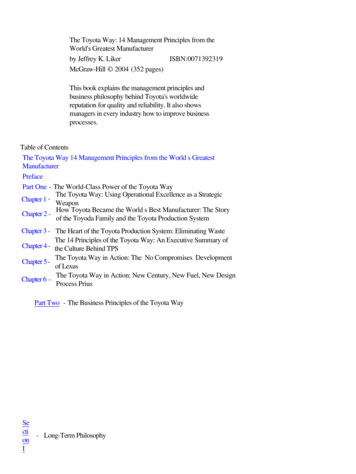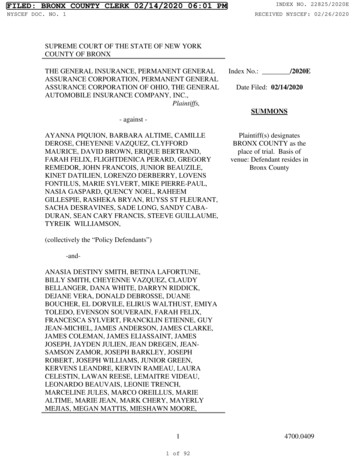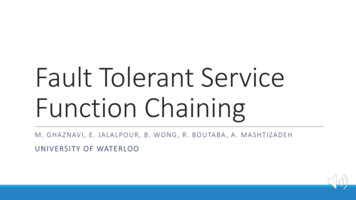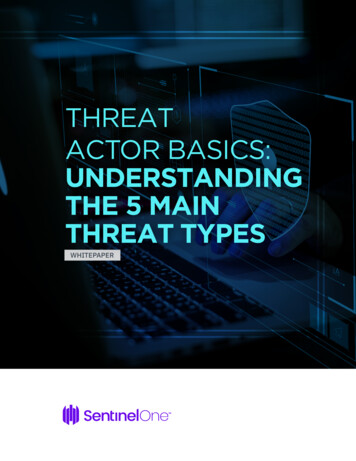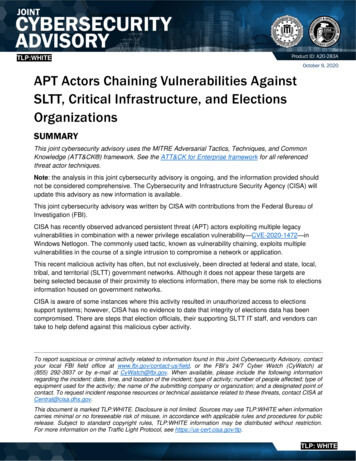
Transcription
TLP:WHITEProduct ID: A20-283AOctober 9, 2020APT Actors Chaining Vulnerabilities AgainstSLTT, Critical Infrastructure, and ElectionsOrganizationsSUMMARYThis joint cybersecurity advisory uses the MITRE Adversarial Tactics, Techniques, and CommonKnowledge (ATT&CK ) framework. See the ATT&CK for Enterprise framework for all referencedthreat actor techniques.Note: the analysis in this joint cybersecurity advisory is ongoing, and the information provided shouldnot be considered comprehensive. The Cybersecurity and Infrastructure Security Agency (CISA) willupdate this advisory as new information is available.This joint cybersecurity advisory was written by CISA with contributions from the Federal Bureau ofInvestigation (FBI).CISA has recently observed advanced persistent threat (APT) actors exploiting multiple legacyvulnerabilities in combination with a newer privilege escalation vulnerability—CVE-2020-1472—inWindows Netlogon. The commonly used tactic, known as vulnerability chaining, exploits multiplevulnerabilities in the course of a single intrusion to compromise a network or application.This recent malicious activity has often, but not exclusively, been directed at federal and state, local,tribal, and territorial (SLTT) government networks. Although it does not appear these targets arebeing selected because of their proximity to elections information, there may be some risk to electionsinformation housed on government networks.CISA is aware of some instances where this activity resulted in unauthorized access to electionssupport systems; however, CISA has no evidence to date that integrity of elections data has beencompromised. There are steps that election officials, their supporting SLTT IT staff, and vendors cantake to help defend against this malicious cyber activity.To report suspicious or criminal activity related to information found in this Joint Cybersecurity Advisory, contactyour local FBI field office at www.fbi.gov/contact-us/field, or the FBI’s 24/7 Cyber Watch (CyWatch) at(855) 292-3937 or by e-mail at CyWatch@fbi.gov. When available, please include the following informationregarding the incident: date, time, and location of the incident; type of activity; number of people affected; type ofequipment used for the activity; the name of the submitting company or organization; and a designated point ofcontact. To request incident response resources or technical assistance related to these threats, contact CISA atCentral@cisa.dhs.gov.This document is marked TLP:WHITE. Disclosure is not limited. Sources may use TLP:WHITE when informationcarries minimal or no foreseeable risk of misuse, in accordance with applicable rules and procedures for publicrelease. Subject to standard copyright rules, TLP:WHITE information may be distributed without restriction.For more information on the Traffic Light Protocol, see https://us-cert.cisa.gov/tlp.TLP: WHITE
FBI CISATLP:WHITESome common tactics, techniques, and procedures (TTPs) used by APT actors include leveraginglegacy network access and virtual private network (VPN) vulnerabilities in association with the recentcritical CVE-2020-1472 Netlogon vulnerability. CISA is aware of multiple cases where the FortinetFortiOS Secure Socket Layer (SSL) VPN vulnerability CVE-2018-13379 has been exploited to gainaccess to networks. To a lesser extent, CISA has also observed threat actors exploiting theMobileIron vulnerability CVE-2020-15505. While these exploits have been observed recently, thisactivity is ongoing and still unfolding.After gaining initial access, the actors exploit CVE-2020-1472 to compromise all Active Directory (AD)identity services. Actors have then been observed using legitimate remote access tools, such as VPNand Remote Desktop Protocol (RDP), to access the environment with the compromised credentials.Observed activity targets multiple sectors and is not limited to SLTT entities.CISA recommends network staff and administrators review internet-facing infrastructure for these andsimilar vulnerabilities that have or could be exploited to a similar effect, including Juniper CVE-20201631, Pulse Secure CVE-2019-11510, Citrix NetScaler CVE-2019-19781, and Palo Alto NetworksCVE-2020-2021 (this list is not considered exhaustive).TECHNICAL DETAILSInitial AccessAPT threat actors are actively leveraging legacy vulnerabilities in internet-facing infrastructure (ExploitPublic-Facing Application [T1190], External Remote Services [T1133]) to gain initial access intosystems. The APT actors appear to have predominately gained initial access via the Fortinet FortiOSVPN vulnerability CVE-2018-13379.Although not observed in this campaign, other vulnerabilities, listed below, could be used to gainnetwork access (as analysis is evolving, these listed vulnerabilities should not be consideredcomprehensive). As a best practice, it is critical to patch all known vulnerabilities within internet-facinginfrastructure. Citrix NetScaler CVE-2020-19781MobileIron CVE-2020-15505Pulse Secure CVE-2019-11510Palo Alto Networks CVE-2020-2021F5 BIG-IP CVE-2020-5902Fortinet FortiOS SSL VPN CVE-2018-13379CVE-2018-13379 is a path traversal vulnerability in the FortiOS SSL VPN web portal. Anunauthenticated attacker could exploit this vulnerability to download FortiOS system files throughspecially crafted HTTP resource 18-384Page 2 of 9 Product ID: A20-283ATLP: WHITE
TLP:WHITEFBI CISAMobileIron Core & Connector Vulnerability CVE-2020-15505CVE-2020-15505 is a remote code execution vulnerability in MobileIron Core & Connector versions10.3 and earlier.2 This vulnerability allows an external attacker, with no privileges, to execute code oftheir choice on the vulnerable system. As mobile device management (MDM) systems are critical toconfiguration management for external devices, they are usually highly permissioned and make avaluable target for threat actors.Privilege EscalationPost initial access, the APT actors use multiple techniques to expand access to the environment. Theactors are leveraging CVE-2020-1472 in Windows Netlogon to escalate privileges and obtain accessto Windows AD servers. Actors are also leveraging the opensource tools such as Mimikatz and theCrackMapExec tool to obtain valid account credentials from AD servers (Valid Accounts [T1078]).Microsoft Netlogon Remote Protocol Vulnerability: CVE-2020-1472CVE-2020-1472 is a vulnerability in Microsoft Windows Netlogon Remote Protocol (MS-NRPC), acore authentication component of Active Directory.3 This vulnerability could allow an unauthenticatedattacker with network access to a domain controller to completely compromise all AD identity services(Valid Accounts: Domain Accounts [T1078.002]). Malicious actors can leverage this vulnerability tocompromise other devices on the network (Lateral Movement [TA0008]).PersistenceOnce system access has been achieved, the APT actors use abuse of legitimate credentials (ValidAccounts [T1078]) to log in via VPN or remote access services (External Remote Services [T1133]) tomaintain persistence.MITIGATIONSOrganizations with externally facing infrastructure devices that have the vulnerabilities listed in thisjoint cybersecurity advisory, or other vulnerabilities, should move forward with an “assume breach”mentality. As initial exploitation and escalation may be the only observable exploitation activity, mostmitigations will need to focus on more traditional network hygiene and user management activities.Keep Systems Up to DatePatch systems and equipment promptly and diligently. Establishing and consistently maintaining athorough patching cycle continues to be the best defense against adversary TTPs. See table 1 forpatch information on CVEs mentioned in this E-2020-1472Page 3 of 9 Product ID: A20-283ATLP: WHITE
FBI CISATLP:WHITETable 1: Patch information for CVEsVulnerabilityVulnerable ProductsPatch InformationCVE-2018-13379 FortiOS 6.0: 6.0.0 to 6.0.4FortiOS 5.6: 5.6.3 to 5.6.7FortiOS 5.4: 5.4.6 to 5.4.12Fortinet Security Advisory:FG-IR-18-384CVE-2019-19781 Citrix Application DeliveryControllerCitrix GatewayCitrix SDWAN WANOPCitrix blog post: firmwareupdates for Citrix ADC andCitrix Gateway versions 11.1and 12.0 Citrix blog post: securityupdates for Citrix SD-WANWANOP release 10.2.6 and11.0.3Citrix blog post: firmwareupdates for Citrix ADC andCitrix Gateway versions 12.1and 13.0Citrix blog post: firmwareupdates for Citrix ADC andCitrix Gateway version 10.5CVE-2020-5902 Big-IP devices (LTM, AAM,Advanced WAF, AFM, Analytics,APM, ASM, DDHD, DNS, FPS,GTM, Link Controller, PEM, SSLO,CGNAT)F5 Security Advisory:K52145254: TMUI RCEvulnerability CVE-2020-5902CVE-2019-11510 Pulse Connect Secure 9.0R1 9.0R3.3, 8.3R1 - 8.3R7, 8.2R1 8.2R12, 8.1R1 - 8.1R15Pulse Policy Secure 9.0R1 9.0R3.1, 5.4R1 - 5.4R7, 5.3R1 5.3R12, 5.2R1 - 5.2R12, 5.1R1 5.1R15Pulse Secure Out-of-CycleAdvisory: Multiplevulnerabilities resolved inPulse Connect Secure / PulsePolicy Secure 9.0RX Page 4 of 9 Product ID: A20-283ATLP: WHITE
FBI CISATLP:WHITEVulnerabilityCVE-2020-15505Vulnerable Products Patch InformationMobileIron Core & Connectorversions 10.3.0.3 and earlier,10.4.0.0, 10.4.0.1, 10.4.0.2,10.4.0.3, 10.5.1.0, 10.5.2.0 and10.6.0.0Sentry versions 9.7.2 and earlier,and 9.8.0;Monitor and Reporting Database(RDB) version 2.0.0.1 and earlierMobileIron Blog: MobileIronSecurity Updates AvailableCVE-2020-1631 Junos OS 12.3, 12.3X48, 14.1X53,15.1, 15.1X49, 15.1X53, 17.2,17.3, 17.4, 18.1, 18.2, 18.3, 18.4,19.1, 19.2, 19.3, 19.4, 20.1Juniper Security AdvisoryJSA11021CVE-2020-2021 PAN-OS 9.1 versions earlier thanPAN-OS 9.1.3; PAN-OS 9.0versions earlier than PAN-OS9.0.9; PAN-OS 8.1 versions earlierthan PAN-OS 8.1.15, and allversions of PAN-OS 8.0 (EOL)Palo Alto Networks SecurityAdvisory for CVE-2020-2021CVE-2020-1472 Windows Server 2008 R2 for x64based Systems Service Pack 1Windows Server 2008 R2 for x64based Systems Service Pack 1(Server Core installation)Windows Server 2012Windows Server 2012 (ServerCore installation)Windows Server 2012 R2Windows Server 2016Windows Server 2019Windows Server 2019 (ServerCore installation)Windows Server, version 1903(Server Core installation)Windows Server, version 1909(Server Core installation)Windows Server, version 2004(Server Core installation) Microsoft Security Advisory forCVE-2020-1472Page 5 of 9 Product ID: A20-283ATLP: WHITE
FBI CISATLP:WHITEComprehensive Account ResetsIf there is an observation of CVE-2020-1472 Netlogon activity or other indications of valid credentialabuse detected, it should be assumed the APT actors have compromised AD administrativeaccounts, the AD forest should not be fully trusted, and, therefore, a new forest should be deployed.Existing hosts from the old compromised forest cannot be migrated in without being rebuilt andrejoined to the new domain, but migration may be done through “creative destruction,” wherein asendpoints in the legacy forest are decommissioned, new ones can be built in the new forest. This willneed to be completed on on-premise as well as Azure-hosted AD instances.Note that fully resetting an AD forest is difficult and complex; it is best done with the assistance ofpersonnel who have successfully completed the task previously.It is critical to perform a full password reset on all user and computer accounts in the AD forest. Usethe following steps as a guide.1. Create a temporary administrator account, and use this account only for all administrativeactions2. Reset the Kerberos Ticket Granting Ticket (krbtgt) password;4 this must be completed beforeany additional actions (a second reset will take place in step 5)3. Wait for the krbtgt reset to propagate to all domain controllers (time may vary)4. Reset all account passwords (passwords should be 15 characters or more and randomlyassigned):a. User accounts (forced reset with no legacy password reuse)b. Local accounts on hosts (including local accounts not covered by Local AdministratorPassword Solution [LAPS])c. Service accountsd. Directory Services Restore Mode (DSRM) accounte. Domain Controller machine accountf. Application passwords5.Reset the krbtgt password again6.Wait for the krbtgt reset to propagate to all domain controllers (time may vary)7.Reboot domain controllers8.Reboot all endpointsThe following accounts should be reset: 4AD Kerberos Authentication Master (2x)All Active Directory AccountsAll Active Directory Admin AccountsAll Active Directory Service AccountsAll Active Directory User AccountsDSRM Account on Domain resetting-the-krbtgt-passwordPage 6 of 9 Product ID: A20-283ATLP: WHITE
FBI CISATLP:WHITE Non-AD Privileged Application AccountsNon-AD Unprivileged Application AccountsNon-Windows Privileged AccountsNon-Windows User AccountsWindows Computer AccountsWindows Local AdminCVE-2020-1472To secure your organization’s Netlogon channel connections: Update all Domain Controllers and Read Only Domain Controllers. On August 11, 2020,Microsoft released software updates to mitigate CVE-2020-1472. Applying this update todomain controllers is currently the only mitigation to this vulnerability (aside from removingaffected domain controllers from the network).Monitor for new events, and address non-compliant devices that are using vulnerableNetlogon secure channel connections.Block public access to potentially vulnerable ports, such as 445 (Server Message Block[SMB]) and 135 (Remote Procedure Call [RPC]).To protect your organization against this CVE, follow advice from Microsoft, including: Update your domain controllers with an update released August 11, 2020, or later.Find which devices are making vulnerable connections by monitoring event logs.Address non-compliant devices making vulnerable connections.Enable enforcement mode to address CVE-2020-1472 in your environment.VPN VulnerabilitiesImplement the following recommendations to secure your organization’s VPNs: Update VPNs, network infrastructure devices, and devices being used to remote into workenvironments with the latest software patches and security configurations. See CISA TipsUnderstanding Patches and Software Updates and Securing Network Infrastructure Devices.Wherever possible, enable automatic updates. See table 1 for patch information on VPNrelated CVEs mentioned in this report.Implement multi-factor authentication (MFA) on all VPN connections to increasesecurity. Physical security tokens are the most secure form of MFA, followed by authenticatorapp-based MFA. SMS and email-based MFA should only be used when no other forms areavailable. If MFA is not implemented, require teleworkers to use strong passwords. See CISATips Choosing and Protecting Passwords and Supplementing Passwords for moreinformation.Page 7 of 9 Product ID: A20-283ATLP: WHITE
FBI CISATLP:WHITEDiscontinue unused VPN servers. Reduce your organization’s attack surface by discontinuingunused VPN servers, which may act as a point of entry for attackers. To protect your organizationagainst VPN vulnerabilities: Audit configuration and patch management programs.Monitor network traffic for unexpected and unapproved protocols, especially outbound to theinternet (e.g., Secure Shell [SSH], SMB, RDP).Implement MFA, especially for privileged accounts.Use separate administrative accounts on separate administration workstations.Keep software up to date. Enable automatic updates, if available.How to uncover and mitigate malicious activityWhen addressing potential incidents and applying best practice incident response procedures: Collect and remove for further analysis:o Relevant artifacts, logs, and data Implement mitigation steps that avoid tipping off the adversary that their presence in thenetwork has been discovered.Consider soliciting incident response support from a third-party IT security organization to:o Provide subject matter expertise and technical support to the incident response.o Ensure that the actor is eradicated from the network.o Avoid residual issues that could result in follow-up compromises once the incident isclosed. RESOURCES CISA VPN-Related GuidanceCISA Infographic: Risk Vulnerability And Assessment (RVA) Mapped to the MITRE ATT&CKFRAMEWORKNational Security Agency InfoSheet: Configuring IPsec Virtual Private NetworksCISA Joint Advisory: AA20-245A: Technical Approaches to Uncovering and RemediatingMalicious ActivityCISA Activity Alert: AA20-073A: Enterprise VPN SecurityCISA Activity Alert: AA20-031A: Detecting Citrix CVE-2019-19781CISA Activity Alert: AA20-010A: Continued Exploitation of Pulse Secure VPN VulnerabilityCybersecurity Alerts and Advisories: Subscriptions to CISA Alerts and MS-ISAC AdvisoriesCONTACT INFORMATIONRecipients of this report are encouraged to contribute any additional information that they may haverelated to this threat.Page 8 of 9 Product ID: A20-283ATLP: WHITE
FBI CISATLP:WHITEFor any questions related to this report or to report an intrusion and request resources for incidentresponse or technical assistance, please contact: CISA (888-282-0870 or Central@cisa.dhs.gov), orThe FBI through the FBI Cyber Division (855-292-3937 or CyWatch@fbi.gov) or a local fieldofficeFEEDBACKCISA strives to make this report a valuable tool for our partners and welcomes feedback on how thispublication could be improved. You can help by answering a few short questions about this report atthe following URL: https://www.us-cert.gov/forms/feedback.Page 9 of 9 Product ID: A20-283ATLP: WHITE
Palo Alto Networks CVE-2020-2021 F5 BIG-IP CVE-2020-5902 Fortinet FortiOS SSL VPN CVE-2018-13379 CVE-2018-13379 is a path traversal vulnerability in the FortiOS SSL VPN web portal. An unauthenticated attacker could exploit this vulnerability to download FortiOS system files through specially crafted HTTP resource requests. 1



